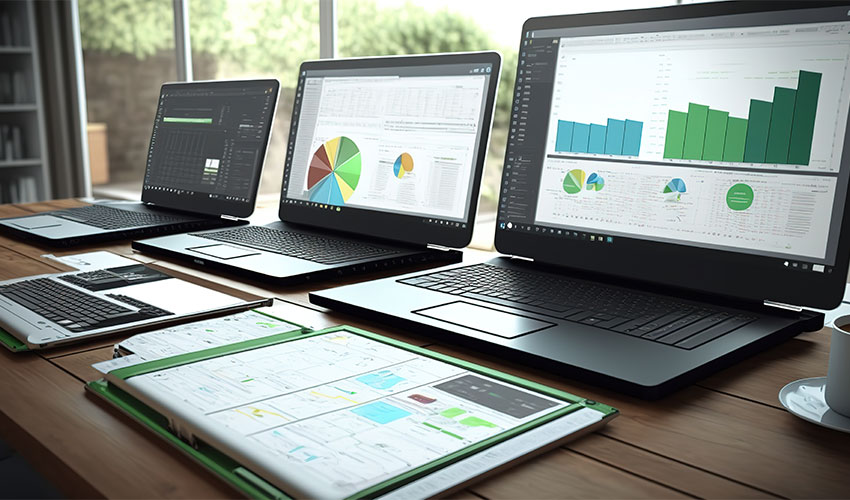Subscribe
Subscribe to EduBridge Blogs
Microsoft Excel is a popular spreadsheet software that is widely used for data analysis, calculations, and visualization. Excel allows users to create, organize, and manipulate data in a tabular format, making it a powerful tool for various tasks, such as budgeting, financial analysis, data tracking, and more.
Excel provides a wide range of features and functions that enable users to perform calculations, create charts and graphs, and analyze data. It has a grid of cells organized into rows and columns, where users can enter data, perform calculations, and create formulas to automate calculations.
Excel supports a vast array of mathematical and logical functions, such as addition, subtraction, multiplication, division, and more. These functions can be combined to create complex formulas for performing calculations on data. Excel also supports macros, which are recorded actions that can be automated to perform repetitive tasks.
Excel is commonly used in various industries, including finance, accounting, business, science, engineering, and many others. It is a versatile tool that provides users with the ability to analyze, manipulate, and visualize data efficiently and effectively. Whether you are a beginner or an advanced user, Excel offers a wide range of functionalities to support your data analysis and management needs.
Now that we know, how useful Excel is as a tool let us dig in a little deeper and learn more about what is Excel and how to use Microsoft Excel for free. Using this tool is pretty simple and if you are a beginner who is trying to figure out how to use Excel as a beginner, you have come to the right place.

What is Excel?
Eate, organize, and analyze data in a tabular format, using a grid of cells arranged in rows and columns. Each cell can contain data, formulas, or functions, making Excel a versatile tool for performing calculations, data analysis, and visualization.
Excel offers a wide range of features and functions, including mathematical and logical operations, data formatting, charting, pivot tables, and more. Users can enter data manually, import data from external sources, or use data from other Office applications like Word or PowerPoint.
One of Excel’s key features is its ability to create formulas and functions that perform calculations on data. Formulas in Excel can include mathematical operations, references to other cells, and logical statements. Excel also has an extensive library of built-in functions, such as SUM, AVERAGE, MAX, MIN, IF, VLOOKUP, and many others, which can be used to perform a wide range of calculations on data.
What are the Benefits of using Excel?
Using Excel as a spreadsheet software offers numerous benefits, making it a popular tool for data analysis, calculations, and visualization. Some of the key benefits of using Excel include:
- Data organization: Excel provides a tabular format with rows and columns that allows users to organize data in a structured manner. Data can be entered manually, imported from external sources, or copied and pasted from other applications, making it easy to create and maintain data sets.
- Data analysis and calculations: Excel offers a wide range of built-in functions and formulas that enable users to perform various mathematical, statistical, and logical calculations on data. These functions allow for data analysis, trend analysis, financial calculations, and more, making Excel a powerful tool for complex calculations.
- Flexibility: Excel is a versatile tool that can handle different types of data, from numerical to text, dates, and more. It allows users to customize data formats, apply conditional formatting, and manipulate data in various ways to suit their needs.
- Visualization: Excel provides a variety of charting and graphing options that allow users to create visual representations of data, making it easier to understand and analyze complex data sets. Users can create bar charts, line charts, pie charts, and many other types of charts to visualize data trends and patterns.
- Automation: Excel allows users to automate repetitive tasks using macros, which are recorded actions that can be played back to perform tasks quickly and efficiently. Macros can be used to automate data formatting, calculations, and other tasks, saving time and effort.
- Collaboration: Excel supports collaborative work, allowing multiple users to work on the same spreadsheet simultaneously. Users can share and edit spreadsheets in real time, add comments, and track changes, making it easy to collaborate on data analysis projects.
- Customization: Excel offers a high level of customization, allowing users to create customized templates, add-ins, and macros to suit their specific needs. This flexibility allows users to tailor Excel to their specific requirements, making it a powerful tool for diverse industries and use cases.
- Accessibility: Excel is widely used and supported, with a large user community and extensive online resources available for learning and troubleshooting. It is also compatible with other Microsoft Office applications, allowing for seamless integration and data exchange between different Office tools.
- Time-saving: Excel’s built-in functions, formulas, and automation capabilities can significantly save time when it comes to data analysis, calculations, and reporting. It allows users to process and manipulate large amounts of data quickly and efficiently, improving productivity.
Overall, Excel is a powerful and versatile tool that offers a wide range of benefits for data analysis, calculations, and visualization. Its flexibility, automation capabilities, and user-friendly interface make it a popular choice for professionals across various industries.
Isn’t it a great tool? But how do you use Excel? Which steps should you follow? Let’s find out.

A step-by-step guide on How to use Excel.
Step 1: Launch Excel and Open a New Workbook
- Open Microsoft Excel on your computer.
- Click on “Blank Workbook” or “New Workbook” to create a new Excel file.
Step 2: Enter Data into Cells
- Enter data into cells by clicking on a cell and typing the desired data. Press Enter to move to the next cell.
- Use the Tab key to move to the cell on the right or the Enter key to move to the cell below.
- You can also copy and paste data from other sources into Excel.
Step 3: Format Data
- Format data by selecting cells or ranges and applying formatting options from the toolbar or right-click menu.
- You can change font styles, sizes, and colours, and apply formatting such as bold, italic, underline, etc.
- You can also apply number formatting, and date formatting, and customize cell borders, alignment, and more.
Step 4: Perform Calculations
- Use Excel’s built-in functions and formulas to perform calculations on data.
- Click on a cell where you want the result to appear, enter an equal sign (=), and then enter the function or formula followed by the arguments.
- For example, to sum a range of numbers, enter “=SUM(A1:A10)” where A1:A10 is the range of cells you want to sum.
- Press Enter to get the result.
Step 5: Create Charts
- Select the data range you want to visualize in a chart.
- Click on the “Insert” tab in the toolbar and choose the type of chart you want to create, such as a bar chart, line chart, pie chart, etc.
- Customize the chart by right-clicking on various chart elements, such as title, axis labels, data series, etc.
- You can also change chart types, colours, and other formatting options.
Step 6: Use Formulas and Functions
- Excel has a vast library of built-in functions for various calculations, such as SUM, AVERAGE, MAX, MIN, IF, VLOOKUP, and more.
- To use a function, click on a cell where you want the result, enter an equal sign (=), then type the function name followed by the arguments enclosed in parentheses.
- For example, to calculate the average of a range of numbers, enter “=AVERAGE(A1:A10)” where A1:A10 is the range of cells you want to average.
Step 7: Use Conditional Formatting
- Conditional formatting allows you to apply formatting to cells based on certain conditions.
- Select the range of cells you want to apply conditional formatting to.
- Click on the “Home” tab in the toolbar, and choose “Conditional Formatting” from the “Styles” group.
- Choose the type of conditional formatting, such as highlighting cells that are greater than, less than, equal to, etc., and specify the formatting options.
Step 8: Use Data Sorting and Filtering
- Excel allows you to sort and filter data to analyze it more effectively.
- Select the range of cells you want to sort or filter.
- Click on the “Data” tab in the toolbar, and choose “Sort” or “Filter” from the “Sort & Filter” group.
- Follow the prompts to specify the sorting or filtering criteria.
Step 9: Protect and Save your Workbook
- You can protect your workbook to prevent unauthorized changes.
- Click on the “Review” tab in the toolbar, and choose “Protect Workbook” from the “Changes” group.
- Follow the prompts to set a password or specify other protection settings.
- To save your workbook, click on the “File” tab in the toolbar, and choose “Save As” to specify the file
In conclusion, Microsoft Excel is a powerful and user-friendly spreadsheet application that offers a wide range of features for organizing, analyzing, and visualizing data. With its intuitive interface and extensive library of functions and formulas, Excel is accessible to users of all skill levels, from beginners to advanced users. Its ability to handle complex calculations, create professional charts and graphs, and apply formatting and conditional formatting makes it a versatile tool for a variety of tasks, from simple calculations to complex data analysis. By following the step-by-step guide outlined above, users can quickly learn how to use Excel and take advantage of its many benefits for efficient data management and analysis.
Recent Blogs
Related Blogs
Accelerate Your Career with Expert Guidance and Guaranteed Job*!
"*" indicates required fields





